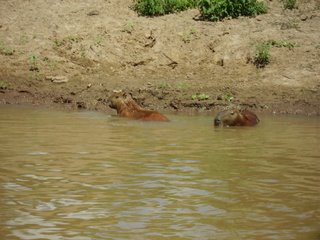Thursday, November 30, 2006

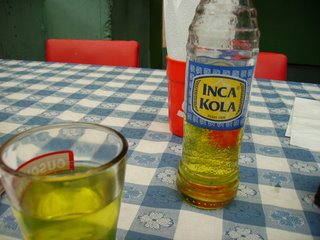
Hark back to Peruvian Culinary experiences!
There´s no doubt while we´re here in Venezuela, the best thing is the politics but we are kinda glad that we´re able to eat arepas (corn rolls stuffed with heaps of yummy stuff) and cachapas (artery blocking corn pancakes with ham and cheese) and drink lots of yummy fresh juices. While in Peru, I bravely ordered roasted guinea pig. But the spirits of Fred and Charlie my guinea pigs when I was little seemed to be screaming in agonies of betrayal as I contemplated the little fellow on my plate. Inca Kola however was much yummier! More revolutionary photos coming soon.
Wednesday, November 22, 2006

you can definitely dance to this revolution
from Green Left Weekly
Campesino, Media and Indigenous Groups March for Chavez
By Simon Butler
CARACAS - Up to 20,000 people mobilised for a 4 hour march through Caracas in a campesino led demonstration in support of the reelection of revolutionary Venezuelan president Hugo Chavez on November 20. The rally was organised by the Ezequiel Zamora Campesino Front (FCEZ) - one of the main revolutionary groups organising rural workers and the landless poor in Venezuela. The weekday mobilisation included thousands of people mobilised by the FCEZ who had made the journey from rural areas outside the capital.A prominent contingent at the front of the demonstration was organised by Popular Union of Venezuelans (UPV) which was theatrically led on horseback by popular UPV leader and Chavista politician Lina Ron. Lina Ron later addressed the rally where according to the November 21 Diario Vea she argued "There is no other possibility, there is no other way, but to recognise this as an important mobilisation for the truimph of [Chavez]." Alan Woods, representing Hands off Venezuela from Britain, also addressed the rally.According to a March 22 report on the demonstration in Venezuela Analysis FCEZ spokesperson, Ramon Elogio Biriguey, stated that their march has two major aims: "One, to give support to President Chavez in the upcoming elections; and two, to push for a 'Zamoran Agenda' against imperialism and in support of the construction of socialism, democratic participation, Venezuela’s natural resources, food security and to further increase the 'revolutionary agrarian reform.'"Venezuela Analysis also reported that that another pro-Chavez march was held concurrently with the FCEZ demonstration and was led by members of community media groups, indigenous organisations, unionists and members of the communal councils. This demonstration marched to the Llagano bridge in Central Caracas - a few blocks away from the campesino demonstration.
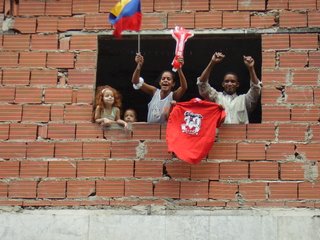
CARACAS!!!!
We´ve only just begun our time here but already we are both so excited about the process that´s unfolding here. Our first night here we met a fabulous Venezuelan woman who´s been living in Australia for years but has returned here to help contribute to the process of change that´s happening here. She told us lots of stories about her family - her father who was protesting the government in the 1950s who kept his hope that a leader would emerge who could lead the Venezuelan people out of the poverty and violence which previous governments perpetuated. This man visited Chavez when he was jailed in the early 90s and when Chavez ran for election in 1998 was the only one in his middle class family who maintained that Chavez would win. Until that time politics in Venezuela had been totally dominated by two parties (right wing and more right wing - sound familiar?). Chavez travelled round and round the country, through the barrios and met with as many people as he could. People weren´t sure whether he would really be any different from the rest of the politicians but he had made the effort to come and talk to ordinary people and they thought it was worth a try. Talking to Eleanora, I realised what an absolute watershed it was even for Chavez to win that first election – no other party but Accion Demoratica or Coppei had won an election in the 50 years or so of official democracy. But not only did Chavez win the election since that time he´s initiated countless social missions across the country. A few years ago Mission Robinson achieved its goal of ensuring that every person in the country can read and write. Now Mission Ribas is established to allow adults who never finished high school to get a secondary education. The other day while having coffee, the waiter asked us whether we supported Chavez or Rosales (the US backed opposition candidate) when we said Chavez, he brought out his Mission Ribas text books and also gave us a booklet about the defence of popular power. There are countless other Missions including Mission Negra Hipolita, which addresses the needs of the critically poor – for example drug addicts and street kids; Mission Barrio Adentro which is now in its 4th stage of redeveloping the country´s health infrastructure – it started with community medical centres, has established a network of diagnostic centres and is now improving the public hospital system; Mission Casa Alimentación which provides free nutritious meals in the community. There´s even been a new mission launched recently to clean up the garbage from the streets of Caracas which is as grubby as any city in the the 3rd world. The main ethos of these missions is that change comes from the grass roots. These aren´t government programs run by bureaucrats from an air-conditioned office, these programs are run by the community, educate and empower the community.
We went to a BBQ the other night where we got to talk to lots of people about the revolutionary process. People are very ambitious about this process, its not going to stop with a slightly better form of capitalism “we might not get to see the revolution but we´re doing this for our children and our children´s children” they told us. “There´ve been more changes in the last 7 years than in the 30 years before but we still have a very long way to go”. People are very aware of the negative portrayal of the Venezuelan process in the international press and wanted us to let people know that in no way is this a violent process. That people are empowered to expect and have education and health as their rights, that people are politicised and are involved in the governing of this country.
We´ve also been on our first rally here, about 20 000 campesinos and their supporters marched in the tropical heat chanting “Zamora – vive vive! La lucha – sigue, sigue”. Zamora was a radical democratic leader of small farmers, the second section translates as the struggle goes on and on. And so did the march for about 4 hours – up hills and down hills, along freeways, past barrios, and it was fantastic. All along the way people waved from windows or came out to wave red flags, Chavez posters or flash 10 fingers the sign for the goal of the campaign to get 10 million votes for Chavez.
Today we went with PDVSA (the state petroleum company) workers to help distribute PDVSA donations to a primary school in one of the largest barrios in Caracas. Schools tell PDVSA what they need, PDVSA purchases the goods, often from cooperatives, and twice a year PDVSA workers go out to different schools and distribute the books, pencils, school bags, geometry sets and food. The kids were stoked as you´ll see when we can upload more pictures. Under previous governments PDVSA technically made these kind of donations but in reality these funds were often skimmed off by corrupt managers. Another factor of the new PDVSA is that the workers are involved in this community building work. Thereby making the links real for both the workers and the students that this really is a national company – that works for the well being of the Venezuelan community.
Big Chavez march tomorrow, will send more news soon.
Tuesday, November 21, 2006


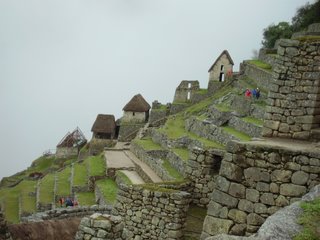

Peru and Maccu Piccu
After saying goodbye to Bolivia via Lago Titikaka (the worlds highest lake) we travelled northward for a week in Peru. It is a country we would have loved to have spent some more time in. But during the week we did manage to visit the two major cities of Cuzso and Lima. One of the highlights of our trip so far must be our visit to the amazing Inca ruins of Maccu Piccu in the Sacred Valley 4 hours out of Cuzco. Unfortunately for our photos it was a bit misty that day but hopefully the shots capture some of the grandeur of this special place. Above are some of our shots from Maccu Piccu.
Cuzco itself is a very impressive city about 3300 metres high in the Peruvian Andes and was the capital of the huge Inca empire prior to the Spanish invasion. The centre of the town retains most of its old Spanish colonial architecture. Older still are the Inca foundations of these buildings that are still visible.
We also spent a couple of days in Lima - the bustling capital city of Peru. It had been a while since we had been in a city as big as Lima (around 5 million people). In the short time we had we were only able to check out the beautiful plazas in the city centre along with the beachside suburb of Miraflores. But hopefully we will be back to see more of Peru and to understand more about Peru's politics, history and culture.
A few days ago we finally arrived here in revolutionary Venezuela. In four days in Caracas we've attended 3 protests in campaigning for the reelection of the popular Venezuelan president Hugo Chavez. One of these demonstrations led by radical campesinos was at least 20,000 people strong and snaked its ways through downtown Caracas for 5 hours. With the brigade organised by the Australia Venezuela Solidarity Network due to begin on Saturday we are in for a fasciniating experience. We will write more on our experiences with and thoughts about the revolutionary process here in the coming days.
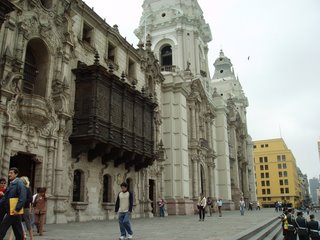
The "Plaza Mejor" in Lima

A view of Cuzco from above
Sunday, November 12, 2006
Thursday, November 09, 2006
Monday, November 06, 2006
Todo es posible, nada es seguro - adventures in Bolivia
(anything is possible, nothing is certain/safe)
Anacondas, tiny planes, the most dangerous road in the world, piranhas, caimans - your favourite adventurers have done it all in the last few weeks.
We spent about 4 days in La Paz we were able to meet up with Nick who runs a great blog on Bolivia check out http://www.nickbuxton.info/ He also showed us an exhibition of a fantastic political Bolivian artist, Walter Solon Romero, read this article about him here. I wanted to find some online examples of his artwork to show you but nada, its a bit reminiscent of Diego Riviera but not just murals - very cool.
However many times you hear people describe the bizarre geography of La Paz, I don´t think anything can prepare you for driving down the road from El Alto, winding down a cliff face into a city which creeps up the walls of a massive cratar. One night we went over to the historic quarter - walking down the steep cobbled streets on one side of the crater we could see all the lights from houses climbing the opposite side of the cratar and we knew that hidden from our view at the cliff top, spread the massive metropolis of El Alto, the fastest growing city in South America. Again frustrated by our lack of language in inability to connect with the many strong political movements in La Paz and El Alto, we tried to satisfy our political cravings by reading grafitti, amongst my favourites were some slogans from Mujeres Creando (Women Creating) "the new man must be able to fry an egg" and "how can we have a revolution when Goni is on vacation?" (i think those translations are correct - apologies to MC if not). The latter slogan is a reference to the growing campaign to bring former president Gonzalo "Goni" Sanchez de Lozada to justice over the killings of over 67 people in El Alto during the 2003 gas war. For more info on this important campaign check out http://juiciogoniya.free.fr/inicio/article.php3?id_article=106
From La Paz we decided to head to the jungle town of Rurrenabaque after hearing the exciting tales from Jo and Reima, our buddies from spanish school. We ran into another buddy from school at the airport, Jane and together we boarded a tiny tin box which the good people of Amazonas swore was a plane. It was seriously tiny as you´ll see when we can post the photos, not even room to stand inside and Simon swears he saw sticky tape on the propellers! Those brave enough to look out the window (ie Simon) had a great view of snow covered mountains until they and us were enveloped in thick cloud, only to emerge 45min laters in a sea of tropical green jungle - really an amazing contrast.
Rurrenabaque, a small town on the River Beni is a weird contrast between sleepy Bolivian backwater and travellers´mecca complete with several "international restaurants" and "jungle bars" where its very rare to see a Bolivian customer. Global inequity aside, its still a really cool place to spend a couple of days. We headed off on a pampas tour which was heaps of fun where we encountered aforementioned pirhanas (we fished for them - Simon caught his first fish ever but Ruth topped the catch, hauling in 7). Also fishing for piranhas with us was an alligator who crept up onto the beach near our campsite every morning. Although we were assured alligators weren´t really dangerous we weren´t too keen to test out this theory. Apparently the ones to really watch out for are the caimans which can grow up to 7 metres in length and are more aggressive. While we weren´t entirely sure about the ecological implications of our guide´s absolute determination to find an anaconda which included digging up any hole which remotely looked like it might contain a snake, it was an amazingly beautiful creature when he finally dragged one out. But it wasn´t all scary creatures out there, we also saw the incredibly cute capyburras which look like a cross between a wombat and a beaver and wade around in the shallows, we saw heaps of turtles, some beautiful birds and even bats and plauges of mosquitoes ("solo mosquitos y comida (food) es seguro en pampas" said Mark, our fearless guide and copyright owner of our new favourite phrase which encapsulates all of Bolivia "todo es posbile, nada es seguro).
Returning to Rurrenabaque for a few capirinhas (my new favourite drink and sure to be a hit at cocktail nights back home) we were all set to fly back to La Paz when the rains came in, turning the landing strip to mud. We waited for a few days but not many planes were flying and we decided it had been scary enough flying in good weather so we found ourselves at 5.30 one morning standing in the mud of the Beni River struggling to load our very large backpacks into a very small and leaky motorised canoe for a 12 hour trip to Guanay. It was a completely beautiful journey through amazing jungle, cloud forests, massive rock columns that looked like that scene from Lord of the Rings (just before they fall off the waterfall!). Our problem wasn´t falling off waterfalls, but due to all the rains the river was quite high and we were going upstream (the Beni eventually flows into the Amazon) and there were some pretty hairy patches complete with whirlpools, not sure if we need to go whitewater rafting after that. But the good man Christo and his fearless navigator got us there in the end (also thanks to the young boy whose job it was to bail water from the bottom of the boat!). In Guanay I swam in the river and then we watched a full moon rise over the mountains - just one of those moments. We made it to Coroico, a beautiful mountain village. Coincidently the La Paz section of MAS was also having their regional conference there that weekend. The town was full of people in t-shirts saying "che, fidel, chavez, evo", and the indigenous flag was flying everywhere. Our hotel was just above the MAS conference site and we fell asleep listening to the conference proceedings (entendamos un poco).
The next afternoon we took a minibus up the "most dangerous road in the world" (sorry Mum!) back to La Paz. It was scary but incredibly beautiful.
Currently we´re in Copacabana on the shores of Lake Titicaca, the highest navigable lake in the world. Despite mucho lluvio (rain) it is still very beautiful. Tomorrow we leave Bolivia after 2 amazing months and head to Cuzco, Peru.
Photos coming when posible.









